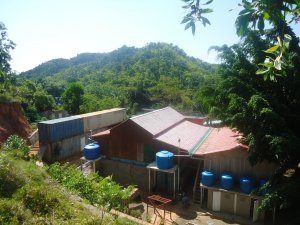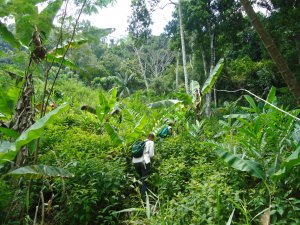I had barely been in Kianjavato for 24 hours, before I found myself at an El Idiote concert, attempting to converse with the MBP field guides and reforestation workers to which I had just been introduced. A week prior, I could only use my imagination to envision how it would feel to be completely immersed in a culture that few Americans are lucky enough to experience. But there I was, listening to live Malagasy tropical music, in a village surrounded by partially forested mountains spotted with distinctive Traveler’s Palms.
Fast forward two weeks, and I’ve now experienced living in a tent for two weeks, showering with a bucket, and eating rice for every meal. The rustic life at KAFS (Kianjavato Ahmason Field Station) requires a willingness to forfeit air conditioning and running water for lemurs and reforestation, but these are sacrifices that all volunteers here are happy to make. When walking from the field station to the tent sites, the surrounding mountains give glimpses into the deforestation that has occurred, the reforestation efforts that are currently underway, and the remaining forests.
The black and white ruffed lemur monitoring team that I am working with collects data in two forest fragments within the Kianjavato region; Sangasanga and Vatovavy. Seven lemurs are collared in each area, allowing the guides to easily locate these focal animals. Black and white  ruffed lemurs form subgroups with high rates of fission fusion, meaning the number of individuals in their group fluctuates based on numerous factors such as food availability and the presence or absence of infants. We follow the focal lemurs for two hours at a time, writing down everything from the tree species the focal lemur is residing in, to various social interactions between lemurs in the focal animal’s group. It is surreal to spend the day gazing up at these primates, watching them groom each other or carefully climb to the tops of Traveler’s Palms for a sip of nectar. For the most part, black and white ruffed lemurs stay at least 10 meters above us in the trees. But occasionally they come a bit closer, sometimes hanging from their feet about 4 meters above us as if to study us. Although it’s a little difficult to photograph animals inhabiting the forest canopy, I am confident that the memories of lemurs leaping from tree to tree will be etched in my mind forever.
ruffed lemurs form subgroups with high rates of fission fusion, meaning the number of individuals in their group fluctuates based on numerous factors such as food availability and the presence or absence of infants. We follow the focal lemurs for two hours at a time, writing down everything from the tree species the focal lemur is residing in, to various social interactions between lemurs in the focal animal’s group. It is surreal to spend the day gazing up at these primates, watching them groom each other or carefully climb to the tops of Traveler’s Palms for a sip of nectar. For the most part, black and white ruffed lemurs stay at least 10 meters above us in the trees. But occasionally they come a bit closer, sometimes hanging from their feet about 4 meters above us as if to study us. Although it’s a little difficult to photograph animals inhabiting the forest canopy, I am confident that the memories of lemurs leaping from tree to tree will be etched in my mind forever.

